 Facebook
Facebook
 X
X
 Instagram
Instagram
 TikTok
TikTok
 Youtube
Youtube
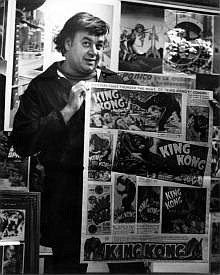
The recent book See You At San Diego: An Oral History of Comic-Con, Fandom, and the Triumph of Geek Culture sets the record straight regarding how pop culture's geekiest get-together became the BFD it is today. Some of those "corrections" mention (if not harp on) San Diego Comic-Con co-founder Shel Dorf, whose 2009 death seemed to inspire almost as much derogatory online commentary as praise. One thing that seemed a constant throughout all accounts - Shel was the original annoying know-it-all name-dropping comic geek. But he certainly wasn't a villain. He was more clueless than cruel. When it comes to assessing his legacy in the comic book industry that he helped nurture and grow into what it is today, his perpetually adolescent mindset was both his strength and weakness.
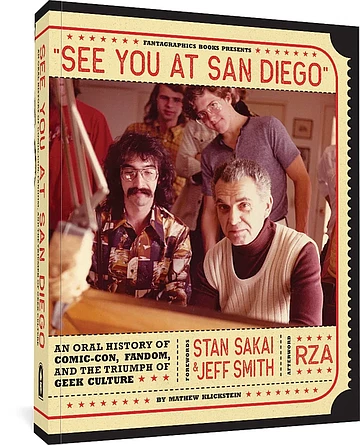
Before I even met Shel, he knew my former employer at Rock 'N' Roll Comics, Revolutionary Comics founder Todd Loren, back when Todd was first doing comic conventions around Detroit. Shel was involved with throwing Detroit pop culture cons as early as the mid-1960s, before moving to San Diego in 1969. I didn't begin attending the local Comic-Con until 1983, when it was being held at downtown's Community Concourse and its Civic Theater and Golden Hall, but from then I went every year up until I retired from comic book publishing in 2000. Shel withdrew from the Con in 1984, but not until after my first-ever professional "comic-creator" Con pass came courtesy of friends of Shel, who let me attend his farewell party where I met dozens of comic creators and publishers who'd later be instrumental in my own career.
One of my biggest professional or personal thrills to date was drawing a little skullface barbarian onto a gigantic wall-size paper gift-card that everyone at Shel's party was drawing on that night, along with personal messages of cheer and well wishes - I sheepishly scribbled my art between drawings by the likes of Berni Wrightson, Frank Brunner, and John Pound, feeling for all the world like an interloper and imposter, brazenly defacing Shel's giant greeting card with my own inadequate scrawl.

But then Shel walked over, shook my hand, and thanked me ---- I cite that as the very moment I became a professional comic book creator. It was, after all, through Shel that I first got to meet many of the creators I later worked with at Rock 'N' Roll Comics, Carnal Comics, Comic Zone Productions, Personality Comics, etc. In addition, thanks to Shel's introductions, from the early 80s and into the early 90s, my partner and I drew most all of the signs seen at San Diego Comic-Cons - that's what earned us free passes every year.
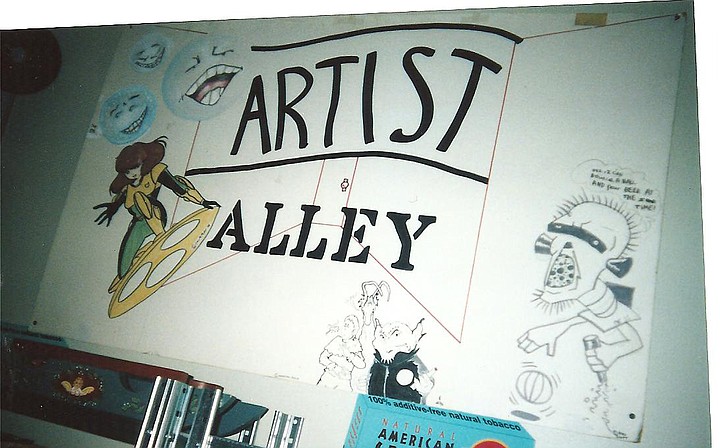
We'd hand-create hundreds of signs covered in comic characters, pointing to specific rooms or events or drawing up comical programming schedules, that kind of thing. Even the big counter signs like "Security," those giant paintings of comic characters toting guns were all drawn by me and my partner and a handful of friends we'd recruit in return for their own convention passes. I'm not sure I ever really repaid Shel for getting me that big break.
Unlike some publicly shared (and re-shared) accounts of Shel seeking "tit-for-tat" reciprocal favors, Shel never lorded his influence on my career over me, nor asked for anything in return...other than friendship.
I got to know Shel a bit better when I was working for local comic publisher Pacific Comics, as detailed in a 2005 Reader cover story "Two Men and Their Comic Books." When that company went under, one of its co-founding brothers Steve Schanes decided to get right back into the comic biz, saying "We needed to create a corporation quickly, so we set up a company headquarters in our two-story house and took the name of the street that we lived on, Blackthorne Avenue, and called it Blackthorne Publishing."
I went to work for Steve in his basement office near Grossmont High and his rented warehouse on Johnson Avenue off Fletcher Parkway (the warehouse shared space with Boundy Rocking Horses, which handcrafted adult-size horsie toys). While I was disappointed in what had gone down at Pacific, Steve had always treated me fairly, paid me nicely and, well, he clearly needed some help getting Blackthorne off the ground.

Blackthorne's first release, in spring 1985, was Sheena, Queen of the Jungle, a comic book of reprinted quarter-century-old stories. It was originally scheduled as a Pacific publication, spiffed up inside and on the cover with newly drawn artwork by local Dave Stevens, whose Rocketeer comic began at Pacific. Continuing on with cost-effective comic-strip reprints, Steve made a deal to repackage old Ripley's Believe It or Not columns into comic-book format, each issue having a theme such as "Crime and Murder" or "Feats of Wonder." It was cheap to produce, with no up-front artist fees, and yet lucrative, especially when marketed in bookstores and through mall-type outlets and animation-themed gift boutiques. Other properties licensed for comics by Blackthorne included Star Wars, GI Joe, and Transformers.
San Diego Comic-Con co-founder Shel Dorf was an editor on the locally published Dick Tracy reprints from Blackthorne
Blackthorne's Dick Tracy reprint series was overseen and edited by Shel, a friend of Steve's since the early '70s, when both were part of an informal local comic collector's club. Around a hundred Blackthorne Dick Tracy comics were published, as well as twenty-four book collections of the same material, most of it cut and pasted into comic book format by Shel himself, using little more than a lightbox, scissors, commercial paste-up glue sticks, and Blackthorne's photocopy machine. Dick Tracy creator Chester Gould's daughter, Jean Gould O'Connell, publicly credited Shel for his role in bringing the character to life for "another generation."
Shel used to letter the Steve Canyon comic strip for creator Milt Caniff over the final dozen or so years of its run. His interviews with Caniff were transcribed for the University Press of Mississippi publication Milton Caniff: Conversations. Shel often mentioned Caniff when he came to Steve's Blackthorne headquarters to pick up packages of materials for the reprint comics. He always availed himself of any opportunity to talk about the people he knew, places he'd been, and the comics and creators that he adored - especially stories where he somehow played a personal role. And these weren't imaginary fanboy musings, either. Caniff even created a football player character based on Shel named Thud Shelley who made several Steve Canyon appearances. Marvel and DC legend Jack Kirby drew Shel into his Mister Miracle comic book as a character named Himon. Shel was also hired as a consultant for Warren Beatty's 1990 Dick Tracy film adaptation, with promotional photos showing him on the set sharing his Blackthorne comic book proofs with Beatty himself.
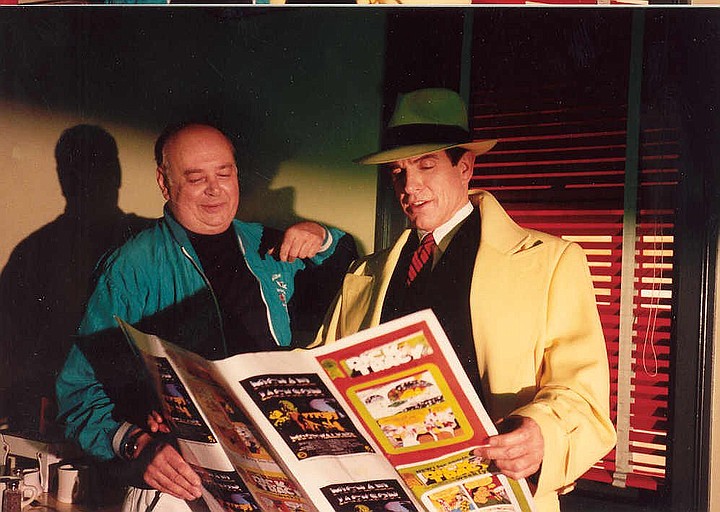
Many years after Blackthorne, around 1992, I went to lunch with Shel and Revolutionary Comics publisher Herb Shapiro. I was surprised to find that Shel actually remembered me from as far back as that 1984 Comic-Con retirement party, though I imagine he only remembered me because I was the one stranger he'd never met before that night, but who defaced his giant greeting card anyway.
During lunch, Shel looked at me and said "I had a feeling right from the start that you were one of the good guys in comics." I've been striving ever since to live up to that pronouncement.
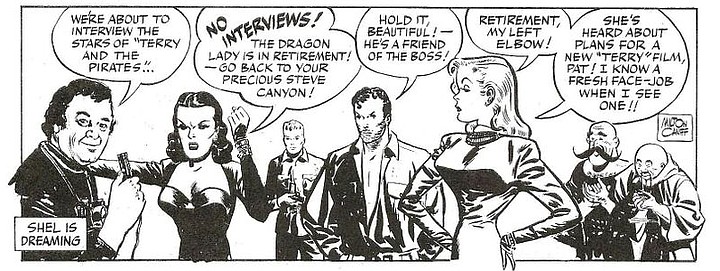
See You At San Diego: An Oral History of Comic-Con, Fandom, and the Triumph of Geek Culture corrects most of the errors and misconceptions perpetuated by Rolling Stone's error-riddled 2017 feature, "San Diego Comic-Con: The Untold History." The book includes one long section that repeats several stories told about Shel through the years, including how he'd seem to use his access to comic stars like Jack Kirby to impress contemporaries with unplanned and almost certainly unwanted drop-by visits to the Kirby home. One longtime comic creator who played a role in founding Comic-Con frequently seems to go out of his way to damage his otherwise genial industry persona to publicly insult Shel at every opportunity.
In truth, if the things that creator claims that Shel said and did are true (and they do sound like poor awkward Shel), I can certainly understand his continued - and nearly festering - hatred of Shel. But, again, I genuinely feel that Shel was clueless, not cruel. Nowadays, he'd probably be diagnosed autistic, with many social behaviors and considerations that most of us take for granted utterly inexplicable in his own mind.
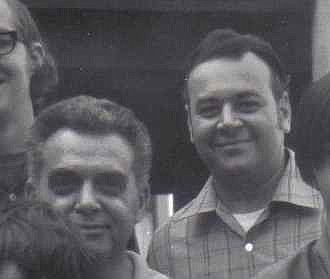
Having spent many years living in OB, Shel Dorf passed away after a long hospitalization at the age of 76 on November 3, 2009 at Sharp Memorial Hospital due to complications related to diabetes. His brother, Michael Dorf, was at his side until the end. Shel was buried next to his parents at the Home of Peace Cemetery. “The guy just lived and breathed comics his whole life,” comic and television scripter Mark Evanier told the San Diego Union-Tribune. “The Con was built on his passion and his cheerleading.” The Shel Dorf Awards, launched in 2010, have been presented at various pop culture conventions back in his early stomping grounds around Michigan.
The San Diego Comic-Con that Shel Dorf co-founded (now known as Comic-Con International) has yet to stage a Shel Dorf Awards show.


The recent book See You At San Diego: An Oral History of Comic-Con, Fandom, and the Triumph of Geek Culture sets the record straight regarding how pop culture's geekiest get-together became the BFD it is today. Some of those "corrections" mention (if not harp on) San Diego Comic-Con co-founder Shel Dorf, whose 2009 death seemed to inspire almost as much derogatory online commentary as praise. One thing that seemed a constant throughout all accounts - Shel was the original annoying know-it-all name-dropping comic geek. But he certainly wasn't a villain. He was more clueless than cruel. When it comes to assessing his legacy in the comic book industry that he helped nurture and grow into what it is today, his perpetually adolescent mindset was both his strength and weakness.

Before I even met Shel, he knew my former employer at Rock 'N' Roll Comics, Revolutionary Comics founder Todd Loren, back when Todd was first doing comic conventions around Detroit. Shel was involved with throwing Detroit pop culture cons as early as the mid-1960s, before moving to San Diego in 1969. I didn't begin attending the local Comic-Con until 1983, when it was being held at downtown's Community Concourse and its Civic Theater and Golden Hall, but from then I went every year up until I retired from comic book publishing in 2000. Shel withdrew from the Con in 1984, but not until after my first-ever professional "comic-creator" Con pass came courtesy of friends of Shel, who let me attend his farewell party where I met dozens of comic creators and publishers who'd later be instrumental in my own career.
One of my biggest professional or personal thrills to date was drawing a little skullface barbarian onto a gigantic wall-size paper gift-card that everyone at Shel's party was drawing on that night, along with personal messages of cheer and well wishes - I sheepishly scribbled my art between drawings by the likes of Berni Wrightson, Frank Brunner, and John Pound, feeling for all the world like an interloper and imposter, brazenly defacing Shel's giant greeting card with my own inadequate scrawl.

But then Shel walked over, shook my hand, and thanked me ---- I cite that as the very moment I became a professional comic book creator. It was, after all, through Shel that I first got to meet many of the creators I later worked with at Rock 'N' Roll Comics, Carnal Comics, Comic Zone Productions, Personality Comics, etc. In addition, thanks to Shel's introductions, from the early 80s and into the early 90s, my partner and I drew most all of the signs seen at San Diego Comic-Cons - that's what earned us free passes every year.

We'd hand-create hundreds of signs covered in comic characters, pointing to specific rooms or events or drawing up comical programming schedules, that kind of thing. Even the big counter signs like "Security," those giant paintings of comic characters toting guns were all drawn by me and my partner and a handful of friends we'd recruit in return for their own convention passes. I'm not sure I ever really repaid Shel for getting me that big break.
Unlike some publicly shared (and re-shared) accounts of Shel seeking "tit-for-tat" reciprocal favors, Shel never lorded his influence on my career over me, nor asked for anything in return...other than friendship.
I got to know Shel a bit better when I was working for local comic publisher Pacific Comics, as detailed in a 2005 Reader cover story "Two Men and Their Comic Books." When that company went under, one of its co-founding brothers Steve Schanes decided to get right back into the comic biz, saying "We needed to create a corporation quickly, so we set up a company headquarters in our two-story house and took the name of the street that we lived on, Blackthorne Avenue, and called it Blackthorne Publishing."
I went to work for Steve in his basement office near Grossmont High and his rented warehouse on Johnson Avenue off Fletcher Parkway (the warehouse shared space with Boundy Rocking Horses, which handcrafted adult-size horsie toys). While I was disappointed in what had gone down at Pacific, Steve had always treated me fairly, paid me nicely and, well, he clearly needed some help getting Blackthorne off the ground.

Blackthorne's first release, in spring 1985, was Sheena, Queen of the Jungle, a comic book of reprinted quarter-century-old stories. It was originally scheduled as a Pacific publication, spiffed up inside and on the cover with newly drawn artwork by local Dave Stevens, whose Rocketeer comic began at Pacific. Continuing on with cost-effective comic-strip reprints, Steve made a deal to repackage old Ripley's Believe It or Not columns into comic-book format, each issue having a theme such as "Crime and Murder" or "Feats of Wonder." It was cheap to produce, with no up-front artist fees, and yet lucrative, especially when marketed in bookstores and through mall-type outlets and animation-themed gift boutiques. Other properties licensed for comics by Blackthorne included Star Wars, GI Joe, and Transformers.
San Diego Comic-Con co-founder Shel Dorf was an editor on the locally published Dick Tracy reprints from Blackthorne
Blackthorne's Dick Tracy reprint series was overseen and edited by Shel, a friend of Steve's since the early '70s, when both were part of an informal local comic collector's club. Around a hundred Blackthorne Dick Tracy comics were published, as well as twenty-four book collections of the same material, most of it cut and pasted into comic book format by Shel himself, using little more than a lightbox, scissors, commercial paste-up glue sticks, and Blackthorne's photocopy machine. Dick Tracy creator Chester Gould's daughter, Jean Gould O'Connell, publicly credited Shel for his role in bringing the character to life for "another generation."
Shel used to letter the Steve Canyon comic strip for creator Milt Caniff over the final dozen or so years of its run. His interviews with Caniff were transcribed for the University Press of Mississippi publication Milton Caniff: Conversations. Shel often mentioned Caniff when he came to Steve's Blackthorne headquarters to pick up packages of materials for the reprint comics. He always availed himself of any opportunity to talk about the people he knew, places he'd been, and the comics and creators that he adored - especially stories where he somehow played a personal role. And these weren't imaginary fanboy musings, either. Caniff even created a football player character based on Shel named Thud Shelley who made several Steve Canyon appearances. Marvel and DC legend Jack Kirby drew Shel into his Mister Miracle comic book as a character named Himon. Shel was also hired as a consultant for Warren Beatty's 1990 Dick Tracy film adaptation, with promotional photos showing him on the set sharing his Blackthorne comic book proofs with Beatty himself.

Many years after Blackthorne, around 1992, I went to lunch with Shel and Revolutionary Comics publisher Herb Shapiro. I was surprised to find that Shel actually remembered me from as far back as that 1984 Comic-Con retirement party, though I imagine he only remembered me because I was the one stranger he'd never met before that night, but who defaced his giant greeting card anyway.
During lunch, Shel looked at me and said "I had a feeling right from the start that you were one of the good guys in comics." I've been striving ever since to live up to that pronouncement.

See You At San Diego: An Oral History of Comic-Con, Fandom, and the Triumph of Geek Culture corrects most of the errors and misconceptions perpetuated by Rolling Stone's error-riddled 2017 feature, "San Diego Comic-Con: The Untold History." The book includes one long section that repeats several stories told about Shel through the years, including how he'd seem to use his access to comic stars like Jack Kirby to impress contemporaries with unplanned and almost certainly unwanted drop-by visits to the Kirby home. One longtime comic creator who played a role in founding Comic-Con frequently seems to go out of his way to damage his otherwise genial industry persona to publicly insult Shel at every opportunity.
In truth, if the things that creator claims that Shel said and did are true (and they do sound like poor awkward Shel), I can certainly understand his continued - and nearly festering - hatred of Shel. But, again, I genuinely feel that Shel was clueless, not cruel. Nowadays, he'd probably be diagnosed autistic, with many social behaviors and considerations that most of us take for granted utterly inexplicable in his own mind.

Having spent many years living in OB, Shel Dorf passed away after a long hospitalization at the age of 76 on November 3, 2009 at Sharp Memorial Hospital due to complications related to diabetes. His brother, Michael Dorf, was at his side until the end. Shel was buried next to his parents at the Home of Peace Cemetery. “The guy just lived and breathed comics his whole life,” comic and television scripter Mark Evanier told the San Diego Union-Tribune. “The Con was built on his passion and his cheerleading.” The Shel Dorf Awards, launched in 2010, have been presented at various pop culture conventions back in his early stomping grounds around Michigan.
The San Diego Comic-Con that Shel Dorf co-founded (now known as Comic-Con International) has yet to stage a Shel Dorf Awards show.
Comments